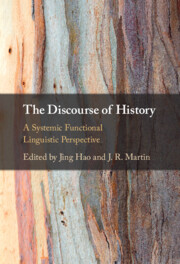Refine search
Actions for selected content:
6584 results in Grammar and Syntax
1 - Building Historical Knowledge through Language: A Systemic Functional Linguistic Perspective
-
-
- Book:
- The Discourse of History
- Published online:
- 16 May 2024
- Print publication:
- 23 May 2024, pp 1-15
-
- Chapter
- Export citation
4 - Interpreting History: Valuing Events in a Postcolonial World
-
-
- Book:
- The Discourse of History
- Published online:
- 16 May 2024
- Print publication:
- 23 May 2024, pp 73-94
-
- Chapter
- Export citation
Contributors
-
- Book:
- The Discourse of History
- Published online:
- 16 May 2024
- Print publication:
- 23 May 2024, pp xii-xiv
-
- Chapter
- Export citation
Tables
-
- Book:
- The Discourse of History
- Published online:
- 16 May 2024
- Print publication:
- 23 May 2024, pp ix-xi
-
- Chapter
- Export citation

The Discourse of History
- A Systemic Functional Linguistic Perspective
-
- Published online:
- 16 May 2024
- Print publication:
- 23 May 2024
7 - Computational Approaches to Language
-
- Book:
- The Philosophy of Theoretical Linguistics
- Published online:
- 25 April 2024
- Print publication:
- 02 May 2024, pp 157-182
-
- Chapter
- Export citation
9 - Conclusion
-
- Book:
- The Philosophy of Theoretical Linguistics
- Published online:
- 25 April 2024
- Print publication:
- 02 May 2024, pp 205-206
-
- Chapter
- Export citation
1 - Introduction
-
- Book:
- The Philosophy of Theoretical Linguistics
- Published online:
- 25 April 2024
- Print publication:
- 02 May 2024, pp 1-22
-
- Chapter
- Export citation
Index
-
- Book:
- The Philosophy of Theoretical Linguistics
- Published online:
- 25 April 2024
- Print publication:
- 02 May 2024, pp 229-232
-
- Chapter
- Export citation
8 - Language and Evolution
-
- Book:
- The Philosophy of Theoretical Linguistics
- Published online:
- 25 April 2024
- Print publication:
- 02 May 2024, pp 183-204
-
- Chapter
- Export citation
References
-
- Book:
- The Philosophy of Theoretical Linguistics
- Published online:
- 25 April 2024
- Print publication:
- 02 May 2024, pp 207-228
-
- Chapter
- Export citation
6 - Signs, Sounds, Action!
-
- Book:
- The Philosophy of Theoretical Linguistics
- Published online:
- 25 April 2024
- Print publication:
- 02 May 2024, pp 137-156
-
- Chapter
- Export citation
Tables
-
- Book:
- The Philosophy of Theoretical Linguistics
- Published online:
- 25 April 2024
- Print publication:
- 02 May 2024, pp viii-viii
-
- Chapter
- Export citation
Contents
-
- Book:
- The Philosophy of Theoretical Linguistics
- Published online:
- 25 April 2024
- Print publication:
- 02 May 2024, pp v-vi
-
- Chapter
- Export citation
Acknowledgements
-
- Book:
- The Philosophy of Theoretical Linguistics
- Published online:
- 25 April 2024
- Print publication:
- 02 May 2024, pp xi-xii
-
- Chapter
- Export citation
Frontmatter
-
- Book:
- The Philosophy of Theoretical Linguistics
- Published online:
- 25 April 2024
- Print publication:
- 02 May 2024, pp i-iv
-
- Chapter
- Export citation
Preface
-
- Book:
- The Philosophy of Theoretical Linguistics
- Published online:
- 25 April 2024
- Print publication:
- 02 May 2024, pp ix-x
-
- Chapter
- Export citation
2 - What Is a Possible Human Language?
-
- Book:
- The Philosophy of Theoretical Linguistics
- Published online:
- 25 April 2024
- Print publication:
- 02 May 2024, pp 23-49
-
- Chapter
- Export citation
5 - Context and Pragmatics
-
- Book:
- The Philosophy of Theoretical Linguistics
- Published online:
- 25 April 2024
- Print publication:
- 02 May 2024, pp 108-136
-
- Chapter
- Export citation
3 - Syntactic Metatheory
-
- Book:
- The Philosophy of Theoretical Linguistics
- Published online:
- 25 April 2024
- Print publication:
- 02 May 2024, pp 50-79
-
- Chapter
- Export citation
